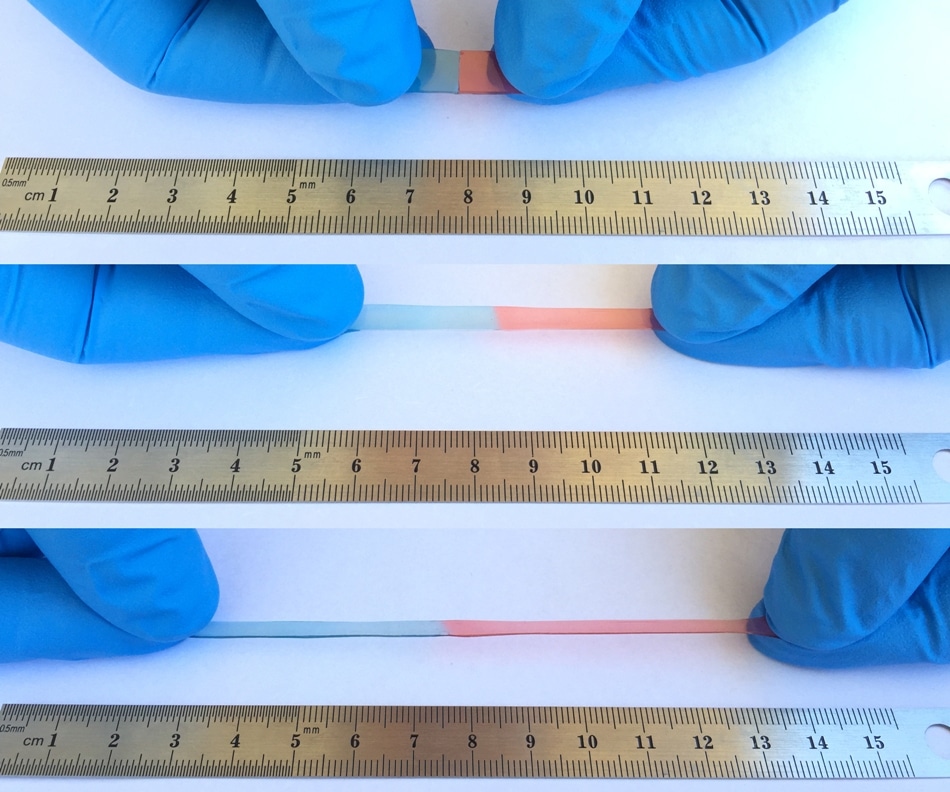Apr 5 2017
 A new material not only heals itself, but it also stretches up to 50 times its usual size; these properties could fix your phone’s battery if it cracks or prevent it from breaking in the first place. (Credit: Wang lab)
A new material not only heals itself, but it also stretches up to 50 times its usual size; these properties could fix your phone’s battery if it cracks or prevent it from breaking in the first place. (Credit: Wang lab)
Inspired by the Marvel Universe, researchers have created a self-healing polymeric material with an aim to develop self-repairing electronics and soft robotics. The polymeric material is transparent, stretchable, and conducts ions to create current. It could one day help a broken smartphone to stitch itself back together.
The research team will present the results of their study at the 253rd National Meeting & Exposition of the American Chemical Society (ACS), the world’s largest scientific society. The ACS expo, which is being held from 2 to 6 April, 2017, features over 14,000 presentations on a variety of science topics.
When I was young, my idol was Wolverine from the X-Men. He could save the world, but only because he could heal himself. A self-healing material, when carved into two parts, can go back together like nothing has happened, just like our human skin. I’ve been researching making a self-healing lithium ion battery, so when you drop your cell phone, it could fix itself and last much longer.
Chao Wang, Ph.D.
Chemical bonding holds the key to self-repair. Wang explained that materials have two types of bonds. Covalent bonds are strong and do not readily reform after they break down. On the other hand, non-covalent bonds are weaker but more dynamic.
For instance, the hydrogen bonds are non-covalent, linking water molecules to one another, breaking, and reforming continuously to promote the fluid properties of water.
Most self-healing polymers form hydrogen bonds or metal-ligand coordination, but these aren’t suitable for ionic conductors.
Chao Wang, Ph.D
As a result, Wang’s research team at the University of California, Riverside, turned to another type of non-covalent bond referred to as an ion-dipole interaction - a force between polar molecules and charged ions. “Ion-dipole interactions have never been used for designing a self-healing polymer, but it turns out that they’re particularly suitable for ionic conductors,” Wang says.
During the development of the material, the main design idea was to employ a polar, stretchable polymer, poly(vinylidene fluoride-co-hexafluoropropylene), along with a mobile, ionic salt. Here, the ion-dipole interactions between the polar groups in the ionic salt and the polymer connect the polymer chains to one another.
The material obtained could stretch up to 50 times its original size. When the material was torn in two, it fully and automatically stitched itself back together within a single day.
As part of a test, Wang’s team placed a non-conductive membrane between two layers of the ionic conductor to create an “artificial muscle”. The novel material was able to respond to electrical signals, which allowed the artificial muscles to move.
The word ‘artificial muscles’ was used, because biological muscles also move in a similar fashion in response to electrical signals (although Wang’s materials are not meant for medical use).
In order to further enhance the material’s properties, the researchers are looking for ways to alter the polymer. For instance, they are testing the material in high humidity and other adverse conditions.
Previous self-healing polymers haven’t worked well in high humidity. Water gets in there and messes things up. It can change the mechanical properties. We are currently tweaking the covalent bonds within the polymer itself to get these materials ready for real-world applications.
Chao Wang, Ph.D
The study was funded by start-up funds from the University of California, Riverside.